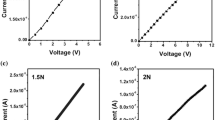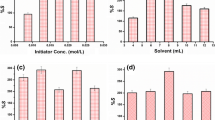Abstract
Interpenetrating network of guar gum and polyacrylamide has been made by simultaneous polymerization and crosslinking. Two different crosslinkers have been used to control the network structure. The amide groups in the network have been subsequently hydrolyzed by controlled saponification to obtain different degrees of ionic content in the gel. The gels containing –NH2 and –COOH functionalities have been characterized by FTIR, elemental analysis, DSC and TGA techniques. The swelling of the gel and pH responsiveness have been evaluated. The suitability of the gel as adsorbent material for removal of cationic dyes from aqueous solution has been investigated with crystal violet and azure B. The results revealed high degree of pH responsiveness and high dye adsorption capacity of gels. The adsorption–desorption processes were observed to be effective in repeated cycles, indicating the reusability of the gels for dye removal applications. The adsorption is observed to occur by Fickian diffusion and pseudo-second-order kinetic model appears to describe the adsorption. Crystal violet was absorbed to higher extent and bound stronger than azure B by the gel network. The adsorption is described by Langmuir model in case of crystal violet and Freundlich model for azure B. The thermodynamic parameters of adsorption indicate exothermic adsorption leading to ordered arrangement of dye molecules on the gel.









Similar content being viewed by others
References
Shin BM, Ji-Heung Kim, Chung DJ (2013) Synthesis of pH-responsive and adhesive super- absorbent hydrogel through bulk polymerization. Macromol Res 21:582–587
Bayramoglu G, Altıntas B, Arica MY (2009) Adsorption kinetics and thermodynamic parameters of cationic dyes from aqueous solutions by using a new strong cation-exchange resin. Chem Eng J 15:339–346
Murthy PSK, Mohan YM, Varaprasad K, Sreedhar B, Raju KM (2008) First successful design of semi-IPN hydrogel–silver nanocomposites: a facile approach for antibacterial application. J Colloid Interface Sci 318:217–224
Guilherme MR, Reis AV, Paulino AT, Fajardo AR, Muniz EC, Tambourgi EB (2007) Superabsorbent hydrogel based on modified polysaccharide for removal of Pb2+ and Cu2+ from water with excellent performance. J Appl Polym Sci 105:2903–2909
Bhattacharyya R, Ray SK (2013) Kinetic and equilibrium modeling for adsorption of textile dyes in aqueous solutions by carboxymethyl cellulose/poly(acrylamide-co-hydroxyethyl methacrylate) semi-interpenetrating network hydrogel. Polym Eng Sci 53:2439–2453
Hu X, Deng Y (2015) Synthesis and swelling properties of silk sericin-g-poly(acrylic acid/attapulgite) composite superabsorbent. Polym Bull 72:487–501
Moralis DV, Rivas BL (2015) Poly(2-acrylamidoglycolic acid-co-2-acrylamide-2-methyl-1-propane sulfonic acid) and poly(2-acrylamidoglycolic acid-co-4-styrene sodium sulfonate): synthesis, characterization, and properties for use in the removal of Cd(II), Hg(II), Zn(II), and Pb(II). Polym Bull 72:339–352
Alikutty P, Abdul MVM, Zubair MA, Muraleedharan K, Mujeeb RP (2014) Studies on the sorption capacity for Pb(II) and Hg(II) of citralidene chitosan. Polym Bull 71:1919–1932
Mandal B, Ray SK (2013) Synthesis of interpenetrating network hydrogel from poly (acrylic acid-co-hydroxyethyl methacrylate) and sodium alginate: modeling and kinetics study for removal of synthetic dyes from water. Corbohydr Polym 98:257–269
Dragan ES, Dinu MV (2013) Design synthesis and interaction with Cu2+ ions of ice templated composite hydrogels. Res J Chem Environ 17:4–10
Ravi Kumar MNV (2000) A review of chitin and chitosan applications. React Funct Polym 46:1–27
Dragan ES, Apopei DF (2013) Multiresponsive macroporous semi-IPN composite hydrogels based on native or anionically modified potato starch. Carbohydr Polym 92:23–32
Yuryev VP, Cesaro A, Bergthaller WJ (eds) (2002) Starch and starch containing origins-structure, properties and new technologies Starch. Nova Science Publishers Inc, New York
Li Yan, Peter R, Chang PZ, Ma Xiaofei (2012) Characterization of magnetic guar gum-grafted carbon nanotubes and the adsorption of the dyes. Carbohydr Polym 87:1919–1924
Mohanan A, Vishalakshi B, Ganesh S (2011) Swelling and metal ion adsorption characteristics of radiation synthesized stimuli responsive PAAm-KC semi-IPN hydrogels. Sep Sci Techol 46:2041–2048
Ciesielski W, Lii CY, Yen MT, Tomasik P (2003) Interactions of starch with salts of metals from the transition groups. Carbohydr Polym 51:47–56
Ekici S, Guntekin G, Saraydin D (2011) The removal of textile dyes with crosslinked chitosan- poly(acrylamide) adsorbent hydrogels. Polym-Plast Technol 50:1247–1255
Prabaharan M (2011) Prospective of guar gum and its derivatives as controlled drug delivery systems. Int J Biol Macromol 49:117–124
Soppimath KS, Kulkarni RA, Aminabhavi TMA (2000) Study on water transport and drug release from crosslinked guar gum grafted polyacrylamide hydrogel microspheres. Proc Int Symp Control Release Bioact Mater 27:847–848
Hiremath JN, Vishalakshi B (2012) Effect of crosslinking on swelling behaviour of IPN hydrogels of guar gum & polyacrylamide. Der Pharma Chemica 4:946–955
Soppiamath KS, Kulakarni AR, Aminabhavi TMA (2001) Chemically modified polyacrylamide-g-guar gum-based crosslinked anionic microgels as pH-sensitive drug delivery systems: preparation and characterization. J Controlled Release 75:331–345
Tripathy T, Sing RP (2000) High performance flocculating agents based on partially hydrolyzed sodium alginate-g-polyacrylamide. Eur Polym J 36:1471–1476
Paulino AT, Guilherme MR, Reis AV, Campese GM, Muniz EC, Nozaki J (2006) Removal of methylene blue dye from an aqueous media using superabsorbent hydrogel supported on modified polysaccharide. J Colloid Interface Sci 301:55–62
Bayramoglu G, Arica MY (2007) Biosorption of benzidine based textile dyes ‘‘Direct Blue 1 and Direct Red 128’’ using native and heat treated biomass of trametes versicolor. J Hazard Mater 143:135–143
Mukhles S, Makharza S, Sultan W, Ghabboun J, Musa AT, Hasan D (2011) Analysis, characterization and some properties of polyacrylamide-Ni (II) complexes. Int J Phys Sci 6:6280–6285
Dong J, Ozaki Y, Nakashima K (1997) Infrared, raman, and near-infrared spectroscopic evidence for the coexistence of various hydrogen-bond forms in poly(acrylic acid). Macromolecules 30:1111–1117
Kayranli B (2011) Adsorption of textile dyes onto iron based waterworks sludge from aqueous solution: isotherm, kinetic and thermodynamic study. Chem Eng J 173:782–791
Peppas NA, Gurny R, Doelker E, Buri D (1989) Modelling of drug diffusion through swellable polymeric Systems. J Membr Sci 7:241–253
Langmuir I (1918) The adsorption of gases on plane surface of glass, mica and platinum. J Am Chem Soc 40:1361–1403
Acknowledgments
The author JNH gratefully acknowledges UGC for Research Fellowship under the BSR (Basic Science Research) scheme.
Author information
Authors and Affiliations
Corresponding author
Rights and permissions
About this article
Cite this article
Hiremath, J.N., Vishalakshi, B. Evaluation of a pH-responsive guar gum-based hydrogel as adsorbent for cationic dyes: kinetic and modelling study. Polym. Bull. 72, 3063–3081 (2015). https://doi.org/10.1007/s00289-015-1453-x
Received:
Revised:
Accepted:
Published:
Issue Date:
DOI: https://doi.org/10.1007/s00289-015-1453-x




